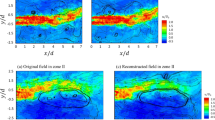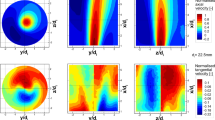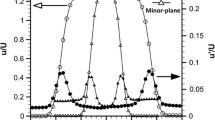Abstract
The triangular oscillating jet nozzle generates a triangular jet partially confined within an axi-symmetric chamber to produce a large scale flow oscillation that has application in thermal processes. Particle image velocimetry and oscillation frequency measurements were conducted to investigate the influence of the jet fluid to ambient fluid density ratio on the resulting oscillating flow. The investigation was conducted with a jet momentum flux of 0.06 kg m s−2 (Re = 7.3−47.2 × 103) and density ratios ranging from 0.2 to 5.0. The initial spread and decay of the emerging jet was found to depend upon the density ratio but in a more complex way than does an unconfined jet. Both the spread and decay are strongly influenced by the instantaneous angle of jet deflection, with greater deflection leading to increased spreading and decay of the jet. Decreasing the density ratio below unity results in a rapid decrease in the deflection angle, while increasing the density ratio above unity results in an increase in the deflection angle, albeit with less sensitivity. The frequency of oscillation was also shown to depend on the density ratio with an increase in the density ratio causing a decrease in the dominant oscillation frequency.















Similar content being viewed by others
References
Amielh M, Djeridane T, Anselmet F, Fulachier L (1996) Velocity near-field of variable density turbulent jets. Int J Heat Mass Transf 39(10):2149–2164
Chen C, Rodi W (1980) Vertical turbulent buoyant jets—a review of experimental data. Pergamon Press Ltd
England G (2009) The effect of density on the near field of a naturally occurring oscillating jet. PhD thesis, Department of Mechanical Engineering, University of Adelaide, Australia
Era Y, Saima A (1977) Turbulent mixing of gases with different densities. Bull JSME 20(139):63–70
Hill SJ, Nathan GJ, Luxton RE (1992) Precessing and axial flows following a sudden expansion in an axisymmetric nozzle. Eleventh Australasian Fluid Mechanics Conference. University of Tasmania, Hobart, Australia
Kay S, Marple S (1981) Spectrum analysis—a modern perspective. Proc IEEE 69(11):1380–1419
Landers T, Lacoss R (1977) Some geophysical applications of autoregressive spectral estimates. IEEE Trans Geosci Electron GE15:26–32
Law AK, Herlina (2002) An experimental study on turbulent circular wall jets. J Hydraul Eng 128(2):161–174
Lee SK, Lanspeary PV, Nathan GJ, Kelso RM, Mi J (2003) Low kinetic-energy loss oscillating-triangular-jet nozzles. Exp Therm Fluid Sci 27:553–561
Manias CG, Nathan GJ (1993) The precessing jet gas burner—a low nox burner providing process efficiency and product quality improvements. World Cement 4–11
Melling A (1997) Tracer particles and seeding for particle image velocimetry. Meas Sci Technol 8:1406–1416
Mi J, Nathan G (2005) Statistical analysis of the velocity field in a mechanical precessing jet flow. Phys Fluids 17
Mi J, Nathan GJ (2004) Self-excited jet-precession strouhal number and its influence on turbulent mixing characteristics. J Fluid Struct 19:851–862
Mi J, Luxton R, Nathan G (1998) Patent: Ep 1 032 789 b1
Nathan G, Mi J, Alwahabi Z, Newbold G, Nobes D (2006) Impacts of a jet’s exit flow pattern on mixing and combustion performance. Prog Energy Combust 32:496–538
Nathan GJ, Hill SJ (2002) Full scale assesment of the influence of a precessing jet of air on the performance of pulverised coal flame in a cement kiln. FCT Internal Report
Nathan GJ, Hill SJ, Luxton RE (1998) An axisymetric ‘fluidic’ nozzle to generate jet precession. J Fluid Mech 370:347–380
Newbold GJR (1998) Mixing and combustion in precessing jet flows. PhD thesis, Department of Mechanical Engineering, University of Adelaide, Australia
Parham JJ, Nathan GJ, Alwahabi ZT (2001) Quantification of mixing characteristics for the optimisation of combustion in rotary kilns. In: 14th Australasian fluid mechanics conference. Adelaide University, Adelaide, pp 805–808
Richards CD, Pitts WM (1993) Global density effects on the self-preservation behaviour of turbulent free jets. J Fluid Mech 254:417–435
Ricou FP, Spalding DB (1961) Measurements of entrainment by axisymmetrical turbulents jets. J Fluid Mech 11:21–32
Ruffin E, Schiestel R, Anselmet F, Amielh M, Fulachier L (1994) Investigation of characteristic scales in variable density turbulent jets using a second-order model. Phys Fluids 6(8):2785–2799
Sautet J, Stepowski J (1998) Evolution of the effective nozzle diameter in the bouyancy free development of turbulent jets with variable density. Exp Fluid 25:280–282
Schneider G, Vidakovic S, Hooper J, Musgrove A, Nathan G, Luxton R (1993) Theoretical and experimental pressure field evaluation downstream of a mechanical precessing jet. In: 4th Australian heat and mass transfer conference, Brisbane
Schneider G, Hooper J, Musgrove A, Nathan G, Luxton R (1997) Velocity and reynolds stresses in a precessing jet flow. Exp Fluid 22:489–495
Smith NL, Megalos NP, Nathan GJ, Zhang DK, Smart JP (1998) Precessing jet burners for stable and low nox pulverised fuel flames—preliminary results from small-scale trials. Fuel 77(9/10):1013–1016
Westerweel J, Scarano F (2005) Universal outlier detection for piv data. Exp Fluid 39:1096–1100
Wong C (2004) The flow within and in the near external field of a fluidic precessing jet nozzle. PhD thesis, Department of Mechanical Engineering, University of Adelaide, Australia
Wong CY, Nathan GJ, O’Doherty T (2002) The effect of different initial conditions on the exit flow from a fluidic precessing jet nozzle. In: 11th international symposium of applications of laser techniques to fluid mechanics, Lisboa, Portugal
Acknowledgments
This research has been jointly supported by the Australian Research Council and the FCT-group of companies through a linkage grant. The TEC Laser Diagnostics laboratory is also supported by the ARC. Helpful discussions with Dr. N. L. Smith and Dr. J. J. Parham are also gratefully acknowledged.
Author information
Authors and Affiliations
Corresponding author
Rights and permissions
About this article
Cite this article
England, G., Kalt, P.A.M., Nathan, G.J. et al. The effect of density ratio on the near field of a naturally occurring oscillating jet. Exp Fluids 48, 69–80 (2010). https://doi.org/10.1007/s00348-009-0706-6
Received:
Revised:
Accepted:
Published:
Issue Date:
DOI: https://doi.org/10.1007/s00348-009-0706-6




